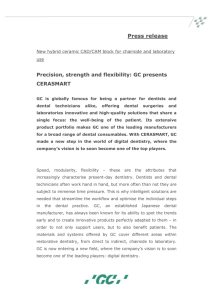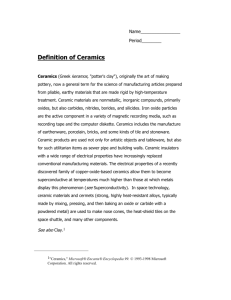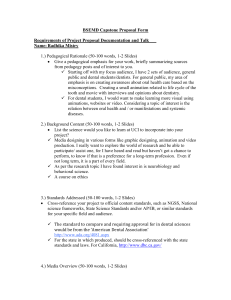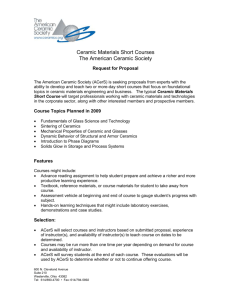Ceramics in Dental Restorations – A Review and - Turkom-Cera
advertisement
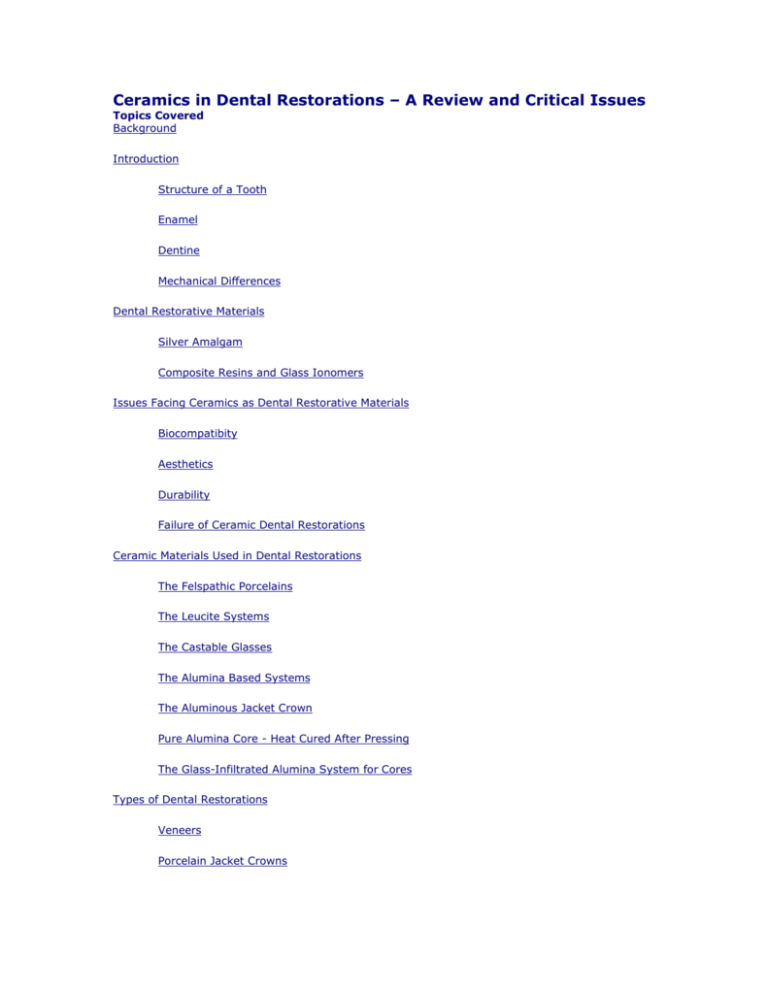
Ceramics in Dental Restorations – A Review and Critical Issues Topics Covered Background Introduction Structure of a Tooth Enamel Dentine Mechanical Differences Dental Restorative Materials Silver Amalgam Composite Resins and Glass Ionomers Issues Facing Ceramics as Dental Restorative Materials Biocompatibity Aesthetics Durability Failure of Ceramic Dental Restorations Ceramic Materials Used in Dental Restorations The Felspathic Porcelains The Leucite Systems The Castable Glasses The Alumina Based Systems The Aluminous Jacket Crown Pure Alumina Core - Heat Cured After Pressing The Glass-Infiltrated Alumina System for Cores Types of Dental Restorations Veneers Porcelain Jacket Crowns Metal-Ceramic Restorations Inlays and Onlays General Discussion Conclusions Background Dental ceramics in restorations are essentially oxide based glass-ceramic systems. They have three essential features/requirements: 1. Ease of fabrication of complex shapes 2. Sufficient mechanical and corrosion resistance 3. Appropriate aesthetic appeal. In the last few decades there has been tremendous advances in the mechanical properties and methods of fabrication of these materials. Whilst porcelain based materials are still a major component of the market there have been moves to replace metal cored systems with all ceramic systems. In this brief review the following topics will be addressed: natural teeth and their properties, alternate restorative materials and the various ceramic compositions and their usage by the dental practitioner. Examples of the microstructure property relationships for these ceramic materials will be addressed. Introduction The history of restorative dentistry can be traced back as far as ancient Egyptian times. Examples of tooth replacement prostheses made from gold wire, ox bone or wood have been found. More recent restoratives had a renaissance about two hundred years ago when air fired porcelains and cast gold restorations were made to restore and replace teeth. It seems that in ancient times the main requirement was to replace teeth lost as a result of gum disease, whereas in recent times it is to restore teeth damaged by decay. Restorations today are largely required as a result of trauma, decay, gum disease and aesthetics. The latter being a more recent area of high demand and one in which ceramic materials play a large role. McLean (1979) provides a concise history of ceramic use in modern dentistry. The use of ceramics for the restoration of teeth has been a part of dentistry's modern period of evolution. This period started in the late seventeen hundreds but major advances have mainly come about this century. The demand for aesthetic restorations led to improvements in ceramic formulation and firing techniques. The types of ceramic systems have been largely summarised by McLean. See also a recent review by Kelly (1997). Structure of a Tooth Enamel Teeth themselves are a complex hard tissue structure originally born from specialised cells called ameloblasts, odontoblasts and cementoblasts. The ameloblasts form the enamel, which is the hard outer coating seen as the clinical crown of the tooth. These cells occur in a layer on the outside of the tooth bud. The enamel is laid down on the inside of the ameloblasts. When the tooth erupts, these cells are lost and enamel can no longer be formed. This has important implications because any wear or loss of enamel due to decay etc, cannot be repaired by the body. Dentine The dentine is formed by the odontoblasts. These cells are on the inner side of the tooth bud, between the enamel and the dental pulp. The dentine is formed by these cells as an inward growth. The dentine could be viewed as the main foundation of the tooth, supporting the enamel, providing protection to the pulp, and through its covering below the gums, giving rise to the attachment via a ligament to the surrounding bone. The dentine has an ability to continue laying down dentine internally at the expense of the pulp chamber size, throughout life. It cannot however, replace dentine that has been physically lost. Figure 1 depicts the lateral view of an incisor tooth. Figure 1. Lateral view of an incisor. Mechanical Differences The mechanical properties and their interelationship of the three hard tissues mentioned above, enamel - dentine - bone, present an interesting method for dealing with stresses applied to the teeth as a result of chewing and also tooth grinding during periods of concentration or psychological stress. The enamel is relatively hard and brittle (E~ 65 70 GPa) the dentine much softer and more compliant (E~ 15 - 19 GPa) and bone even more compliant (E~ 12 GPa). Dental Restorative Materials As mentioned earlier man has been replacing lost tooth structure with gold and ceramic. The gold and ceramic materials were used because they could be custom fabricated to fit the needs of individual tooth requirements as far as form and aesthetics are concerned. They can be used independently or in combination with ceramic baked onto gold alloy subframes. Other metal alloys are also used in this metal-ceramic technique. Silver Amalgam Today as in the past these materials have proved to be relatively expensive for the population masses and alternatives have developed. The first material that was easily produced and relatively inexpensive was silver amalgam. This material, popularised by an American dentist, G. V. Black, in the 1890's has been used very widely throughout the world as a cheap and effective restorative to replace tooth structure lost through decay. The main disadvantages with this material are the concerns over its mercury content and its lack of aesthetic appeal. Composite Resins and Glass Ionomers The other two groups of restorative materials to be used widely are the composite resins and the glass ionomers. The composite resins developed in the 1950's when a breakthrough monomer was produced. Known as BisGMA, this resin monomer has become the backbone of most dental composite resins. These materials use various glass or ceramic particles as fillers to enhance their mechanical properties and give them tooth colouring and other aesthetic properties such as translucency etc. The glass ionomers are a relatively recent development although their predecessor silicate cements have been in use for about the same time as the BisGMA resins. These materials are relatively weak, but are used to cement gold and ceramic crowns to teeth, with other versions being used as direct restoratives, depending on their filler content and the recommended application. They have a major advantage in that their have a reasonably constant fluoride release, acting as a strong decay inhibitor. Issues Facing Ceramics as Dental Restorative Materials The aim of this paper is therefore to review the role of ceramics in dentistry. The first consideration is why use ceramics. The reasons are as follows: Biocompatibility Aesthetics Durability Relative ease for customised units. Biocompatibity The biocompatability issue is essential to prevent adverse reactions within the patients. The dental ceramics in use today have relatively low firing temperatures, usually greater than 900°C and are resistant to dissolution in the mouth. Formulations have been developed with firing temperatures as low as 640°C, however, these materials tend to show considerable surface degradation in the oral environment and hence are not useful. Aesthetics Ceramic materials have long been admired for their aesthetic qualities. The use of dentally coloured glasses can provide replacement structures that can be made to imitate tooth structure in both colour, translucency and response to different lighting sources. Durability Durability is an area that has led to considerable research for ceramic systems that can provide individually constructed restorations, that are small, unique, inexpensive and will be subjected to cyclic loading in wet and sometimes abrasive conditions. The critical problem for all ceramic materials, not the least those used in dentistry is the huge difference in theoretical strength, based on the covalent nature of their structure, and the usual strengths found in general use (7000-70000 MPa versus 7-700 MPa). This was originally determined by Griffith, who reported that the theoretical strength for all solids could generally be regarded as a constant with a value approximating E/10. The advances in industrial ceramics for such conditions have been remarkable to say the least, in recent decades. However, nobody is going to allow their front teeth to be restored with a ceramic that is dark grey, black or opaque white. The advances in industrial ceramics have included improvements in fracture toughness, wear resistance, machinability, solubility, hardness and flexural strength. With the exception of hardness, these are the same improvements that have been sought in dental ceramics. Another major requirement apart from aesthetics is that the ceramic not be too hard otherwise abrasive wear of the opposing natural tooth will be too severe. Failure of Ceramic Dental Restorations The clinical observations tend to show catastrophic mechanical failure. There are reports that ceramic restorations such as inlays and crowns fail due to occlusal (biting together) injury not unlike that of a small spherical indentation. This has led to at least one group using a small spherical indenter of 2 millimetres diameter as a testing devices to produce similar failures in vitro. Perhaps the most important consideration to note are the possible driving forces associated with stresses formed from elastic components within the field of the initial crack. Another consideration is the choice of indenter to produce a failure. In general, the contacts between teeth are the same as small spherical indenters, changing with age and wear to broader, flatter contacts. The cusps of teeth are naturally rounded. As teeth become worn they tend to exhibit small milled facets and so the contacts can become much broader. A spherical indenter rather than a sharp indenter is therefore the system of choice when measuring the behaviour of the ceramic system in question. Ceramic Materials Used in Dental Restorations This has led to a series of differing ceramic structures available for dentistry, with some examples described below. The Felspathic Porcelains Several summaries for the composition of dental porcelain have been written. They cover the composition of felspathic porcelain as a veneering porcelain in all-ceramic and metalceramic crowns. They describe a history of modifying the basic Potash Feldspar-QuartzKaolinite mix by the removal of mullite and free quartz, while increasing sodium oxide and alkaline earth oxides as bivalent glass modifiers, to improve translucent properties while trying to maintain strength. Fluxing agents have also been added to lower the melting temperatures and make them easier to handle in the dental laboratory. These materials are now substantially glassy and Binns (1983) describes their classification as a porcelain as “somewhat of a misnomer”. An approximate location of dental porcelain in the classical tri-axial whiteware formulations is shown in Figure 2. Figure 2. Location of dental porcelains in the classical triaxial whiteware formulations system.. The K2O content was also varied to accommodate the need to match the coefficient of thermal expansion for metal alloys used in dental metal-ceramic techniques. The increase in K2O content allowed a greater proportion of leucite crystals (coefficient of thermal exp. 27 x 10-6/°C) which led to the overall coefficient of thermal expansion rising to something in the order of 13.5 - 15.5 x 10-6/°C. The felspathic porcelains used in all-ceramic systems have coefficients of thermal expansion ranging from 5.5 - 7.5 x 10-6/°C when used over castable glass and alumina based core materials, to 16 x 10-6/°C when used over the newer pressed leucite systems. The Leucite Systems Leucite has been widely used as a constituent of dental ceramics to modify the coefficient of thermal expansion. This is most important where the ceramic is to be fused or baked onto metal. The recent introduction of the pressed leucite reinforced ceramic system, IPS Empress, has leucite in a different role. This material relies on an increased volume of fine leucite particles to increase flexural strength. Similar versions using finely dispersed leucite grains to increase toughness, strength and modify wear patterns and rates to make them similar to enamel wear rates are now available for metal-ceramic restorations. The Castable Glasses The development of glass ceramics by the Corning Glass Works in the late 1950's has led to the creation of a dental ceramic system based on the strengthening of glass with various forms of mica. The Dicor® crown system uses the lost wax system to produce a glass casting of the restoration. The casting is then heat treated or “cerammed”, during which tetra silicic fluromica crystals are formed to increase the strength and toughness of the glass ceramic. This procedure is designed to take place within the economic confines of a commercial dental laboratory. A second dental version was developed to be used for CAD/CAM dental procedures. This cerammed glass is provided in an already heat treated state from the manufacturer. In this latter technique an optical scan of a prepared tooth is loaded into a computer and a milling system is used to produce the restoration. The restoration is then “bonded” to the remaining tooth structure using a dental BisGMA based composite resin. The Alumina Based Systems The Aluminous Jacket Crown The modern Aluminous Jacket Crown, probably more commonly known as the Porcelain Jacket Crown (PJC) was popularised in the mid 1960’s by McLean. This report also points out the importance for the use of alumina in dental ceramics and how it modifies the flaw systems at the surface and within the ceramic. The aluminous porcelains reported by McLean are also very prone to strength degradation when they contain porosity. Pure Alumina Core - Heat Cured After Pressing The Nobel Biocare company from Sweden have introduced two systems that essentially use a system of pressing alumina onto a metal die, removing the pressed shape from the die and then sintering it. One system is used to make alumina profiles that are then used as cores to build up ceramic superstructures for single tooth implants, CeraOne®, and the second is to make cores for conventional crowns, a process known as Procera®. Unlike the other dental ceramic materials, there is no glassy phase present between the particles. Feldspathic veneering porcelains such as Vitadur Alpha@ and Duceram® are then fired onto this alumina core to provide the colour and form for the restoration. The Glass-Infiltrated Alumina System for Cores During the 1980’s, Dr. Michael Sadoun and Vita Zahnfabrik, developed a slip casting system using fine grained alumina. The cast alumina was sintered and then infiltrated with a Lanthana based glass. This provided a glass infiltrated alumina core (In-Ceram®) on which a felspathic ceramic could be baked to provide the functional form and aesthetic component of the restoration. In-Ceram has the highest flexural strength and fracture toughness of all the currently available dental ceramic systems available to most commercial dental laboratories. The system also has the greatest versatility for dental use of any metal free ceramic restorative. The driving force for these developments has been the immense difference in reliability between metal-ceramic systems and all-ceramic systems and a public perception that metal-free restorations are more aesthetic. The disadvantages of the metal ceramic systems include radiopacity, some questions centring around metal biocompatibility and lack of natural aesthetics; important features in today's consumer conscious dental market. Typical mechanical properties of dental ceramics and tooth structures are listed in Table 1. Table 1. Strength of tooth structures and dental ceramics. Material Porcelains Glass Ceramics Alumina Tooth Structures Feldspathic Leucite Lab cast/Cerammed Premade/HIP Alumina/Glass Infiltrated Spinel/Glass Infiltrated Dentine Enamel Flexural Strength (MPa) 60-110 120-180 115-125 140-220 400-600 Fracture Toughness (MPa.m-2) 1.1 1.2 1.9 2.0 3.8-5.0 325-410 2.4 16-20 65-75 2.5 1 These are examples of the different directions that have been chosen to improve mechanical properties while maintaining aesthetic and economic considerations. Types of Dental Restorations The types of restorations involved include: Simple Feldspathic Veneers Porcelain Jacket Crowns and Bridges Metal-Ceramic Crowns and Bridges Inlays and Onlays Implant Superstructures. These systems are shown schematically in Figure 3. Figure 3. Types of dental restorations. A. In-Ceram crown with standard crown design, B. lateral view of In-Ceram crown demonstrating underlying tooth structures, C. lateral view of ceramic crown on a titanium implant and D. porcelain veneer resin bonded to tooth enamel. Veneers The simple veneers are essentially an enamel replacement used mainly for aesthetic reasons on anterior teeth. They are approximately 0.5 mm thick and are glued or “bonded” to the tooth using a dental composite resin. They are very reliant on the mechanical integrity of the supporting tooth to provide enough stiffness to prevent loads flexing the restored tooth and exceeding the critical strain limit of the ceramic veneer. In general, dentists are not aware of the flexibility range for teeth and these restorations are often inappropriately used. Porcelain Jacket Crowns Porcelain Jacket Crowns are a more extensive restoration. These are used to replace virtually all the enamel component and some dentine. This means that they are almost always supported by dentine in a vital tooth, or cast gold in a non-vital tooth. They are at least 1 mm thick and depending on the system used are either made from a single material, as found in Dicor and IPS Empress crowns or are bilaminar such as In-Ceram® and Procera Crowns. In-Ceram® and Procera® use variations of alumina as a toughened and high strength underlying core to support feldspathic veneering porcelain which gives the final shape and aesthetic attributes required for the restoration. In-Ceram® and Procera® are also the only systems that can be used to construct three unit bridges, where missing tooth is replaced using the adjacent teeth as abutments. Metal-Ceramic Restorations Metal-ceramic restorations as described earlier use an alloy, originally based on gold, to form a tough and rigid base for the veneering ceramic. This ceramic usually contains leucite as a coefficient of thermal expansion modifier to reduce stress between the metal and ceramic during the firing process. The modern versions are now using finer and denser dispersions of leucite to improve mechanical properties for wear and flexural strength. Inlays and Onlays Inlays and onlays are made from a variety of the systems mentioned above, with no real preference, although systems containing dispersions of leucite seem to be gaining ground. General Discussion Implant superstructures can be made using the metal-ceramic systems or the alumina based ceramic systems. Despite the substantial improvements in the mechanical properties of dental ceramics there is still an unacceptable degree of failure of these materials in service. These failures often arise because of the dentists and technicians attempts to achieve aesthetic design, particularly of complex multi-tooth bridges. Other failure mechanisms are due to impact failure from opposing teeth or high localised stresses due to hard particulates caught between the teeth, poor adhesion between the ceramic and the underlying tooth or metal support. There is still considerable scope for the further improvement of dental ceramics but not without very careful consideration of the aesthetics and simplicity of fabrication. Conclusions The mechanical properties of these materials have shown a significant improvement during the last few decades with a move towards the all ceramic crown for the more severely loaded posterior application. Some of the unique recent developments such as the simple net shape forming of high strength and high toughness interpenetrating networks of alumina and a lanthana glass ceramics have a wider application than just dental applications. There is still considerable scope for the improvement of properties and microstructures of dental ceramics including a more critical attempt to mimic the structure developed by nature. Note: References for this article are available by referring to the original text. Primary author: J.G. Ironside and M.V. Swain Source: Journal of the Australasian Ceramic Society, Vol. 34 no. 2, pp. 78-91 (1998).

